Family name: Asparagaceae Juss.
Synonym(s): Agavaceae Dumort., nom. cons.; Anemarrhenaceae Conran et al.; Anthericaceae J. Agardh; Aphyllanthaceae Burnett; Aspidistraceae Hassk.; Behniaceae Conran et al.; Convallariaceae Horan.; Dracaenaceae Salisb., nom. cons.; Eriospermaceae Lem.; Eucomidaceae Salisb.; Eustrephaceae Chupov; Funkiaceae Horan., nom. illeg.; Herreriaceae Kunth; Hesperocallidaceae Traub; Hostaceae B. Mathew; Hyacinthaceae Batsch ex Borkh.; Lachenaliaceae Salisb.; Laxmanniaceae Bubani; Lomandraceae Lotsy; Nolinaceae Nakai; Ophiopogonaceae Meisn.; Ornithogalaceae Salisb.; Platymetraceae Salisb., nom. illeg.; Polygonataceae Salisb.; Ruscaceae M. Roem., nom. cons.; Sansevieriaceae Nakai; Scillaceae Vest; Themidaceae Salisb.; Xerotaceae Hassk., nom. illeg.; Yuccaceae J. Agardh;
Common name(s): asparagus family
*Number of genera/species: 114/2,900
List of genera records in GRIN-Global
fruit or seed
Fruit a berryberry:
an indehiscent, fleshy fruit with one or a few to many seeds. The flesh may be homogenous throughout. Or, if the outer part is hard, firm, or leathery, referred to as an hesperidium. Septa are present in some, and the seeds may be arillate or with a fleshy testa.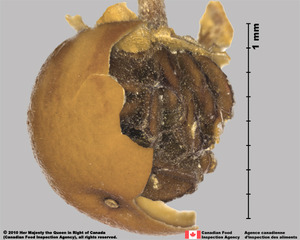 , loculicidalloculicidal:
, loculicidalloculicidal:
type of capsular dehiscence, opening longitudinally through the locules (compare septicidal)
 or septicidalsepticidal:
or septicidalsepticidal:
type of capsular dehiscence, opening longitudinally by separating between the septa of adjacent carpels
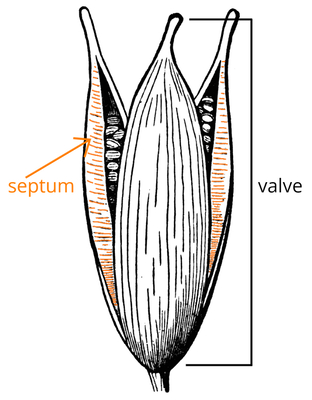 capsulecapsule:
capsulecapsule:
a dry, dehiscent fruit derived from a compound ovary , rarely schizocarpschizocarp:
, rarely schizocarpschizocarp:
usually dry fruit splitting between two or more locules to form distinct, indehiscent, usually one seeded segments; fruit derived from a single, superior or inferior, compound ovary; compare to mericarp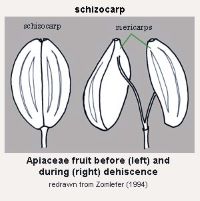 (Ledebouria), 2–230 mm long, globoseglobose:
(Ledebouria), 2–230 mm long, globoseglobose:
3D shape—more or less spherical to angularangular:
to angularangular:
2D shape—having sides that meet at acute or obtuse angles
, sometimes sulcatesulcate:
surface relief—having one or more elongate, relatively narrow and shallow depressions or grooves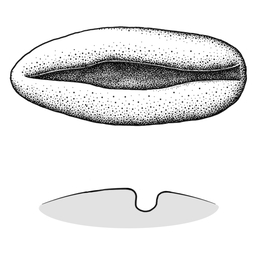 , tereteterete:
, tereteterete:
approximately circular in cross section; width and thickness approximately equal
 or angledangular:
or angledangular:
2D shape—having sides that meet at acute or obtuse angles
in transection, sometimes style or perianth persistent, with one to ten seeds. Pericarp black or brown (capsulecapsule:
a dry, dehiscent fruit derived from a compound ovary ) or red, orange, blue, purple, or black (berryberry:
) or red, orange, blue, purple, or black (berryberry:
an indehiscent, fleshy fruit with one or a few to many seeds. The flesh may be homogenous throughout. Or, if the outer part is hard, firm, or leathery, referred to as an hesperidium. Septa are present in some, and the seeds may be arillate or with a fleshy testa. ), shinyshiny:
), shinyshiny:
uniformly reflecting a high proportion of incident light at all angles or dulldull:
or dulldull:
reflecting only a low proportion of incident light, with no apparent sheen , fleshy to chartaceouschartaceous:
, fleshy to chartaceouschartaceous:
papery, papyraceous
, glabrousglabrous:
without hairs
or pubescentpubescent:
surface relief—bearing hairs
, smooth, ribbed, wartywarty:
surface relief—distinct, rounded projections that are large relative to the fruit size; tuberculate, verrucose , or spinyspiny:
, or spinyspiny:
having slender, stiff, sharp projections oriented in the general plane of the structure . Fruits in Nolina and some species of Chlorophytum are three-winged. Agave species have beakedbeak:
. Fruits in Nolina and some species of Chlorophytum are three-winged. Agave species have beakedbeak:
a usually firm, terminal appendage, sometimes tapered fruits. Eriospermum’s loculicidalloculicidal:
fruits. Eriospermum’s loculicidalloculicidal:
type of capsular dehiscence, opening longitudinally through the locules (compare septicidal)
 capsulescapsule:
capsulescapsule:
a dry, dehiscent fruit derived from a compound ovary (globoseglobose:
(globoseglobose:
3D shape—more or less spherical or lobed) have unique long, unicellular hairs up to 8 mm long.
or lobed) have unique long, unicellular hairs up to 8 mm long.
Seeds globoseglobose:
3D shape—more or less spherical to angledangular:
to angledangular:
2D shape—having sides that meet at acute or obtuse angles
, including discoidaldiscoid:
3D shape—resembling a disc
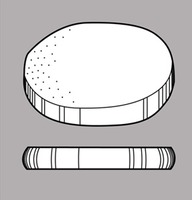 to irregular, tereteterete:
to irregular, tereteterete:
approximately circular in cross section; width and thickness approximately equal
 , angledangular:
, angledangular:
2D shape—having sides that meet at acute or obtuse angles
, or flattened in transection, 0.7–20 mm long. Liriope and Ophiopogon seeds have bright, blue sarcotestassarcotesta:
pulpy or fleshy outer layer of the seed coat, simulates aril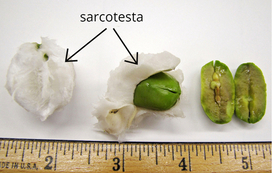 . Seed coat black or brown, rarely orange, red, or white, hard and thin, shinyshiny:
. Seed coat black or brown, rarely orange, red, or white, hard and thin, shinyshiny:
uniformly reflecting a high proportion of incident light at all angles or dulldull:
or dulldull:
reflecting only a low proportion of incident light, with no apparent sheen , smooth, wrinkled, pittedpitted:
, smooth, wrinkled, pittedpitted:
surface relief—surface with small depressions in which the areas between the hollows do not take on the appearance of a true reticular net , papillatepapillate:
, papillatepapillate:
surface relief—bearing minute, distinct, broad-based projections, tapering to a rounded apex , or reticulatereticulate:
, or reticulatereticulate:
surface relief—netted, raised walls or concave grooves forming a net-like surface pattern with flat, concave, or convex interspaces , sometimes pubescentpubescent:
, sometimes pubescentpubescent:
surface relief—bearing hairs
. Seeds in capsular fruits have phytomelanphytomelan:
carbonaceous, opaque material that usually covers the seed coat to give it a black appearance, common in certain monocot families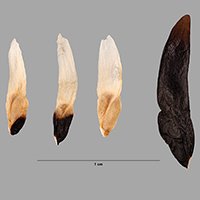 except in Eriospermum.
except in Eriospermum.
ElaiosomesElaiosome:
a lipid and protein-rich fleshy structure attached to some seeds and fruits, it attracts ants which then disperse the disseminule (e.g., caruncle in the Euphorbiaceae, the aril (outgrowth of the funiculus) in the Fabaceae)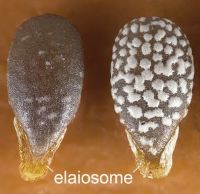 are present in some Caesia, Hensmania, and Stawellia species; white carunclescaruncle:
are present in some Caesia, Hensmania, and Stawellia species; white carunclescaruncle:
a localized outgrowth of the seed coat near the hilum of the seed; it functions as an elaiosome are present in Johnsonia seeds, which are black and reniformreniform:
are present in Johnsonia seeds, which are black and reniformreniform:
2D or 3D shape—kidney-shaped . Seeds are helically winged in Herreria and Herreriopsis.
. Seeds are helically winged in Herreria and Herreriopsis.
Embryo well developed, linearlinear:
(shape) long, narrow, and uniform in width; (of embryo) embryo is straight and much longer than wide , cylindric or broad, straight or curvedcurved:
, cylindric or broad, straight or curvedcurved:
(of embryo) linear embryo is curved into an arch or horseshoe with the ends far apart (Anthericum, Arthropodium, Chlorogalum, Dichopogon, and Thysanotus), axile and centric.
(Anthericum, Arthropodium, Chlorogalum, Dichopogon, and Thysanotus), axile and centric.
Endosperm copious, cartilaginouscartilaginous:
texture—firm, dense, tough, somewhat pliable, and resilient, like cartilage
or hard, smooth or corrugated.
| Fruit | |
| Type | berryberry: an indehiscent, fleshy fruit with one or a few to many seeds. The flesh may be homogenous throughout. Or, if the outer part is hard, firm, or leathery, referred to as an hesperidium. Septa are present in some, and the seeds may be arillate or with a fleshy testa.  , loculicidalloculicidal: , loculicidalloculicidal:type of capsular dehiscence, opening longitudinally through the locules (compare septicidal)  or septicidalsepticidal: or septicidalsepticidal:type of capsular dehiscence, opening longitudinally by separating between the septa of adjacent carpels  capsulecapsule: capsulecapsule:a dry, dehiscent fruit derived from a compound ovary  , rarely a schizocarpschizocarp: , rarely a schizocarpschizocarp:usually dry fruit splitting between two or more locules to form distinct, indehiscent, usually one seeded segments; fruit derived from a single, superior or inferior, compound ovary; compare to mericarp  |
| Size range | 2–230 mm long |
| Shape(s) | globoseglobose: 3D shape—more or less spherical  , ovoidovoid: , ovoidovoid:3D shape—ovate  , oblongoblong: , oblongoblong:2D shape—much longer than broad with nearly parallel sides, corners are rounded  , cylindricalcylindrical: , cylindricalcylindrical:3D shape—a cylinder, with parallel sides and a circular cross-section; tubular or rod-shaped , conicalconical: 3D shape—cone-shaped, with the point of attachment at the broad end 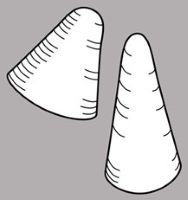 , trigonoustrigonous: , trigonoustrigonous:3D shape—having three faces that meet at distinct angles; triangular in outline , triangulartriangular: 2D shape—three relatively straight sides with distinct corners; more angular than teardrop-shaped  , angledangular: , angledangular:2D shape—having sides that meet at acute or obtuse angles |
| Texture | epicarpepicarp: outer layer of fruit wall or pericarp, if divided into layers; note here used synonymously with exocarp 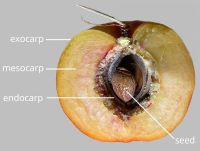 - fleshy, spongyspongy: - fleshy, spongyspongy:soft, light, discontinuous but cohesive, and somewhat resilient , leatheryleathery: texture—moderately thick, tough, and very pliable , chartaceouschartaceous: papery, papyraceous ; mesocarpmesocarp: the middle layer of the pericarp, if divided into layers 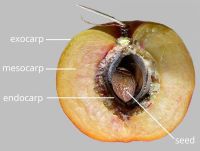 - dry or fleshy - dry or fleshy |
| Surface relief | smooth or ribbedribbed: surface relief—wide, prominent, linear ridges that are generally rounded and longitudinally situated on the surface  , spinyspiny: , spinyspiny:having slender, stiff, sharp projections oriented in the general plane of the structure  , wartywarty: , wartywarty:surface relief—distinct, rounded projections that are large relative to the fruit size; tuberculate, verrucose  |
| Color(s) | red, orange, blue, purple, black, brown |
| Unique features | Black or brown capsulescapsule: a dry, dehiscent fruit derived from a compound ovary  often with flattened, discoiddiscoid: often with flattened, discoiddiscoid:3D shape—resembling a disc  or angularangular: or angularangular:2D shape—having sides that meet at acute or obtuse angles seeds. Or, brightly colored to black berriesberry: an indehiscent, fleshy fruit with one or a few to many seeds. The flesh may be homogenous throughout. Or, if the outer part is hard, firm, or leathery, referred to as an hesperidium. Septa are present in some, and the seeds may be arillate or with a fleshy testa.  with tereteterete: with tereteterete:approximately circular in cross section; width and thickness approximately equal  to angledangular: to angledangular:2D shape—having sides that meet at acute or obtuse angles seeds. In Eriopspermum, capsulescapsule: a dry, dehiscent fruit derived from a compound ovary  with long hairs, up to 8 mm long. with long hairs, up to 8 mm long. |
| Seed | |
| Size range | 0.7–20 mm long |
| Shape(s) | hemisphericalhemispherical: 2D shape—shaped like half a sphere , globoseglobose: 3D shape—more or less spherical  , oblongoblong: , oblongoblong:2D shape—much longer than broad with nearly parallel sides, corners are rounded  , ovoidovoid: , ovoidovoid:3D shape—ovate  , ellipsoidellipsoid: , ellipsoidellipsoid:3D shape—elliptic , cuneiformcuneiform: wedge-shaped , discoidaldiscoid: 3D shape—resembling a disc  , irregular, reniformreniform: , irregular, reniformreniform:2D or 3D shape—kidney-shaped  , conicalconical: , conicalconical:3D shape—cone-shaped, with the point of attachment at the broad end  , teardrop-shapedteardrop-shaped: , teardrop-shapedteardrop-shaped:2D shape—widest point is toward one end of the fruit, the other end tapers sharply to a pointed end 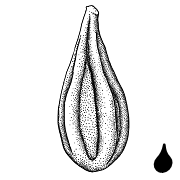 , fusiformfusiform: , fusiformfusiform:spindle-shaped; broadest at the middle and tapering at both ends 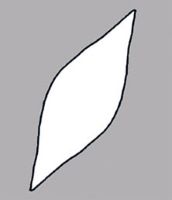 , triangulartriangular: , triangulartriangular:2D shape—three relatively straight sides with distinct corners; more angular than teardrop-shaped  , polygonalpolygonal: , polygonalpolygonal:angular |
| Surface relief | wrinkledwrinkled: surface relief—shallow, irregular folds and furrows covering the surface; appearing overall though crumpled and then spread out  , papillatepapillate: , papillatepapillate:surface relief—bearing minute, distinct, broad-based projections, tapering to a rounded apex  , pittedpitted: , pittedpitted:surface relief—surface with small depressions in which the areas between the hollows do not take on the appearance of a true reticular net  , reticulatereticulate: , reticulatereticulate:surface relief—netted, raised walls or concave grooves forming a net-like surface pattern with flat, concave, or convex interspaces  |
| Color(s) | black, brown, orange, red, blue, white |
| Unique features | Seeds with phytomelanphytomelan: carbonaceous, opaque material that usually covers the seed coat to give it a black appearance, common in certain monocot families  in most genera with capsular fruits. Seeds with bright blue sarcotestasarcotesta: in most genera with capsular fruits. Seeds with bright blue sarcotestasarcotesta:pulpy or fleshy outer layer of the seed coat, simulates aril  in Liriope and Ophiopogon. Seeds in some genera with arilaril: in Liriope and Ophiopogon. Seeds in some genera with arilaril:(broad sense) appendicular structure that wholly or partly envelops a seed and is produced from or a modification of the funicle, raphe, or outer integument; usually fleshy or pulpy, sometimes spongy or tufted-capillate, often brightly colored  or aril-like structures. Seeds helically winged in two genera. or aril-like structures. Seeds helically winged in two genera. |
| Other | |
| Embryo | well developed, axileaxile: on or of the axis and centric in position, linearlinear: (shape) long, narrow, and uniform in width; (of embryo) embryo is straight and much longer than wide  , cylindriccylindrical: , cylindriccylindrical:3D shape—a cylinder, with parallel sides and a circular cross-section; tubular or rod-shaped , or broad in shape, and straight or curvedcurved: (of embryo) linear embryo is curved into an arch or horseshoe with the ends far apart  |
| Nutritive tissue | endosperm copious, cartilaginouscartilaginous: texture—firm, dense, tough, somewhat pliable, and resilient, like cartilage or hard, smooth or corrugated |
World-wide, except Arctic.
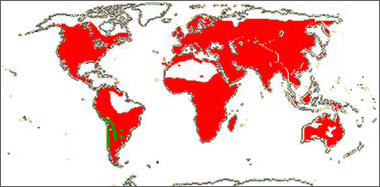
Distribution map courtesy of Angiosperm Phylogeny Website.
Baskin and Baskin 2021Baskin and Baskin 2021:
Baskin C and Baskin J. 2021. Relationship of the lateral embryo (in grasses) to other monocot embryos: A status up-grade. Seed Science Research 31 (3): 199-210. doi:10.1017/S0960258521000209; Dahlgren et al. 1985Dahlgren et al. 1985:
Dahlgren RMT, Clifford HT, and Yeo PF. 1985. The families of the monocotyledons: structure, evolution, and taxonomy. Springer-Verlag, Berlin. 520 pp.; Damen et al. 2018Damen et al. 2018:
Damen THJ, van der Burg WJ, Wiland-Szymańska J, and Sosef MSM. 2018. Taxonomic novelties in African Dracaena (Dracaenaceae). Blumea: Journal of Plant Taxonomy and Plant Geography 63 (1): 31-53. http://dx.doi.org/10.3767/blumea.2018.63.01.05; Davidse et al. 2009–2018Davidse et al. 2009–2018:
Davidse GM, Sousa Sánchez M, Knapp S. and Chiang Cabrera F, eds. 2009–2018. Flora Mesoamericana. Missouri Botanical Garden, St. Louis, MO. Accessed: January–April 2024. URL: http://legacy.tropicos.org/Project/FM; Demissew 2006Demissew 2006:
Demissew S. 2006. Asparagaceae. In: Beentje HJ and Ghazanfar SA, eds. Flora of Tropical East Africa. Vol 16a. Kew, Richmond UK. 23 pp.; Flora of Australia 2021+Flora of Australia 2021+:
Flora of Australia. Australian Biological Resources Study, Canberra. Accessed January 2021–March 2024. URL: http://www.ausflora.org.au; Flora of North America Editorial Committee 1993+Flora of North America Editorial Committee 1993+:
Flora of North America Editorial Committee, eds. 1993+. Flora of North America North of Mexico [Online]. 22+ vols. Flora of North America Association, New York and Oxford. Accessed January-March 2024. URL: http://beta.floranorthamerica.org.; Kirkbride et al. 2006Kirkbride et al. 2006:
Kirkbride JH, Jr, Gunn CR, and Dallwitz MJ. 2006. Family guide for fruits and seeds, vers. 1.0. Accessed September 2020-January 2022. URL: https://nt.ars-grin.gov/seedsfruits/keys/frsdfam/index.cfm .; Kubitzki et al. 1990+Kubitzki et al. 1990+:
Kubitzki K et al., eds. 1990+. The families and genera of vascular plants. 7+ vols. Berlin etc.; Snijman 2013Snijman 2013:
Snijman DA. 2013. Plants of the Greater Cape Floristic Region, Vol 2: The Extra Cape flora. Strelitzia 30. South African National Biodiversity Institute, Pretoria.; Stevens 2001+Stevens 2001+:
Stevens PF. 2001+. Angiosperm Phylogeny Website Version 14, July 2017 [and more or less continuously updated since]. Accessed September 2020-2022. URL: http://www.mobot.org/MOBOT/research/APweb/; Stevenson and Loconte 1995Stevenson and Loconte 1995:
Stevenson DW and Loconte H. 1995. A cladistic analysis of monocot families. In: Rudall PJ, Cribb PJ, Cutler DF, and Humphries CJ, eds. Monocotyledons: Systematics and Evolution. Royal Botanic Gardens, Kew.; Tutin et al. 1964–1980Tutin et al. 1964–1980:
Tutin TG, Burges NA, Chater AO, Edmondson JR, Heywood VH, Moore DM, Valentine DH, Walters SM, and Webb DA (eds.) 1964–1980. Flora Europaea. 5 vols. Cambridge University Press, Cambridge UK. 2,524 pp.; Vislobokov et al. 2013Vislobokov et al. 2013:
Vislobokov NA, Kuznetsov AN, and Sokoloff DD. 2013. A new species of Aspidistra (Ruscaceae s.l., Asparagales) from southern Vietnam, field observations on its flowering and possible pollination by flies (Phoridae). Plant Systematics and Evolution 299 (2): 347-355. http://dx.doi.org/10.1007/s00606-012-0725-2; Watson and Dallwitz 1992+Watson and Dallwitz 1992+:
Watson L and Dallwitz MJ. 1992+. The families of flowering plants: descriptions, illustrations, identification, and information retrieval. Version: 6th Accessed September 2020-September 2022. URL: delta-intkey.com; Zhengyi et al. 2004+Zhengyi et al. 2004+:
Zhengyi W, Raven PH, and Deyuan H. 2004+. Flora of China [online]. 25 vols. Science Press, Beijing China & Missouri Botanical Garden, St. Louis USA. Accessed January–March 2024. http://flora.huh.harvard.edu/china/
*The number of genera and species is based on Christenhusz and Byng 2016Christenhusz and Byng 2016:
Christenhusz MJM and Byng JW. 2016. The number of known plant species in the world and its annual increase. Phytotaxa 261 (3): 201-217. https://doi.org/10.11646/phytotaxa.261.3.1, which may differ from the number of genera in GRIN-Global.